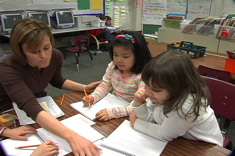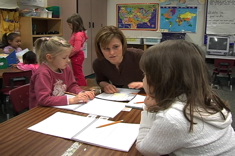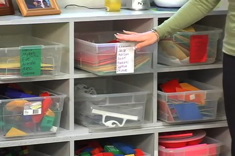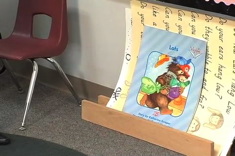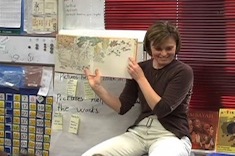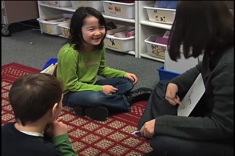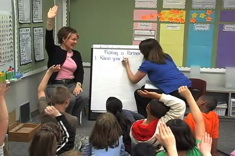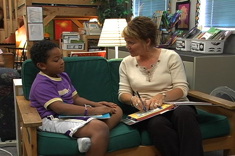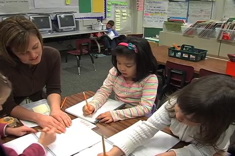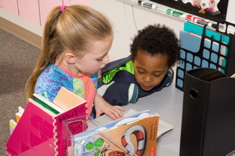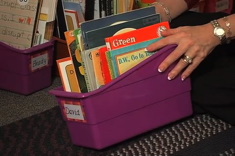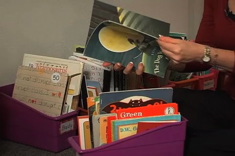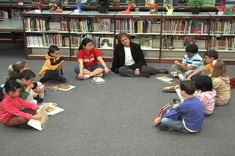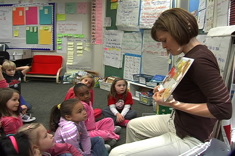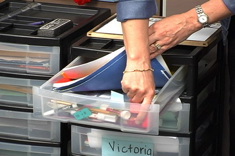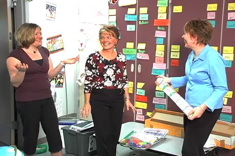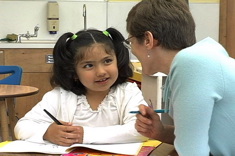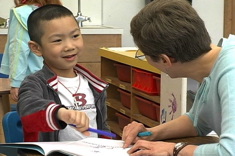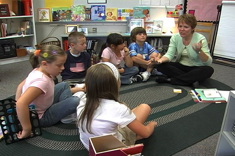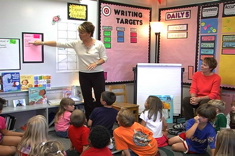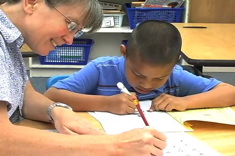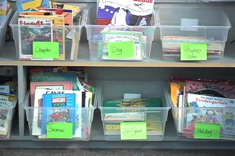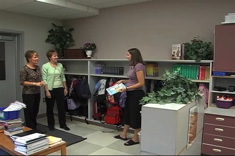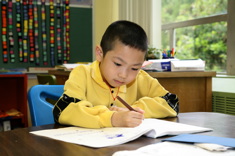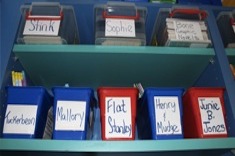1st
Latest Content
Assessing Spelling in Writing Workshop Part 2: Noticing Patterns in Individuals, Small Groups and the Whole Group
Katie DiCesare took on the challenge of developing a one-page assessment tool to analyze the spelling needs and abilities of each of her 1st graders. In the second of her three-part series, Katie shows how she translates the findings from individual students into instructional plans.
Assessing Spelling in Writing Workshop Part 3: Embedding Instruction
In the last installment of this three-part series, Katie DiCesare shows how she translates the findings from individual students into instructional plans when she uses a spelling assessment in her 1st grade classroom.
Organizing for Independence: From Cubbies to Social Groups
In this brief video, Joan Moser talks about how she organizes student materials in "social groups" to avoid the use of desks or cubbies in her classroom.
Big Books and Charts Organizer
In this two-minute video, Joan Moser shares a simple tool teachers can create for their classrooms to keep Big Books, charts, and laminated large materials organized.
Envisioning Writing: Wow Words and Mental Images in 1st Grade
In this minilesson, Katie DiCesare uses the book My Cat Copies Me to help her first-grade students “envision” their writing drafts. The lesson focuses on creating mental images to conjure stronger verbs and adjectives while writing.
Becoming More Purposeful with Writing Share
In this whole-class writing-share session from Katie DiCesare’s first-grade classroom, Katie talks about how she has become more purposeful in connecting student drafts with the minilesson from the start of the writing workshop.
First Grade Small Group: Chunking
In this small group from Courtney Tomfohr's first-grade classroom, students work on their "chunking" skills.
Picking a Partner: Demonstration Lesson and Debrief
In this demonstration lesson from a K-2 classroom, Joan Moser leads students through guided practice in picking a partner.
Conferring with Colin
In this reading conference with Colin, Joan Moser (of “The Sisters”) helps him set a goal of working on accuracy.
First Grade Guided Writing Group: Goldilocks and the 3 Writers
In this video of a first-grade guided writing group, Katie DiCesare works with three girls on spelling issues that have emerged in their writing.
1st Grade Room Tour with Katie DiCesare
In this video tour of her 1st grade classroom, Katie DiCesare highlights the many areas of the room used to support literacy, including the classroom library and wall displays.
Managing Book Boxes
In this first video in our “Organizing Book Boxes” series, Joan Moser (of “The Sisters”) explains three strategies she uses to help students pick books for their book boxes.
Differentiating Book Boxes
In this second video in our "Organizing Book Boxes" series, Joan Moser (of "The Sisters") explains how she differentiates the content of book boxes for students with different skills and needs.
Book Boxes Nuts and Bolts
In this third video in our "Organizing Book Boxes" series, Joan Moser (of "The Sisters") tackles the issue of what types of books and what levels are appropriate for student book boxes.
Tiger Teams: Mixed Age Student Groups
In this video, Karen Szymusiak (the principal at Glacier Ridge Elementary School in Dublin, Ohio) explains how “Tiger Teams” work. Tiger Teams are mixed age groups of K-5 students who meet regularly to talk about their learning and the school community.
Picture Reading in First Grade
In this read-aloud lesson from Katie DiCesare's first-grade classroom, Katie demonstrates the importance of picture reading using the wordless picture book The Zoo by Suzy Lee.
1st Grade Room Tour with Kelly Yahr
In this four-minute video, Kelly Yahr introduces viewers to her 1st grade classroom. Kelly emphasizes how much ownership students have of wall displays and the library, especially through their writing and lettering of materials.
Desk Area Reorganization
In this brief time-lapse video, The Sisters (Gail Boushey and Joan Moser) help Carrie reorganize her desk and rug area for better access to literacy materials and teaching supplies.
Student Storage Areas: Tips for Reorganizing
“The Sisters” (Gail Boushey and Joan Moser) talk with Kelly about strategies for reorganizing student storage areas, considering access, group supplies, and how the materials are used.
Decluttering a Storage Area
In this time-lapse video, “The Sisters” (Gail Boushey and Joan Moser) help second-year teacher Carrie declutter a storage area in May, talking through decisions about what to keep and what to throw away, and simple tricks for dressing up shelves.
Conferring with Leonela: A Two-Day Progression
Leonela is a six-year-old student whose first language is Spanish. In these videos of conferences with Ruth Shagoury filmed over two days, she makes connections between her drawing, writing, and experiences at home and in Mexico.
Conferring with Eddie
Eddie is a six-year-old student who speaks Cantonese as his first language. In this conference with Ruth Shagoury, little English is spoken, and yet there is much communication through gestures and shared history.
Noticing Interesting Words: Small-Group Vocabulary Lesson
In this five-minute video, Gail Boushey leads a short small-group lesson on vocabulary.
Community Language Board: Building Vocabulary All Year Long
“The Sisters” (Gail Boushey and Joan Moser) talk about how the community language board changes and evolves over the year, building a sense of community and shared literacy.
In the Zone: Conferring with a Young English Language Learner
Andie Cunningham confers with kindergartner Cristian within his "ZPD" – Zone of Proximal Development.
Reorganizing the Classroom Library
In this time-lapse video, Gail Boushey and Joan Moser help Carrie, a second-year teacher, begin to organize her classroom library according to themes and traffic patterns in the classroom.
Lighting Redesign from the Sisters
In this five-minute time-lapse video, Gail Boushey and Joan Moser redesign the lighting in their colleague Ahnsaly’s literacy meeting area.
The Sisters Redesign a New Teacher’s Storage Area
The Sisters help a new teacher, Amy, sort through junk she inherited from previous occupants of her classroom. The video uses time-lapse videography to show how the coat, storage, and book area is transformed in the process of winnowing down these materials.
Understanding the “Silent Period” with English Language Learners
Ruth Shagoury and Andie Cunningham explain how to support an English Language Learner who is not speaking with verbal and nonverbal communication strategies.
Chapter Book Read Alouds in the Primary Classroom
Shari Frost considers selection, preparation, and pacing in choosing books that work well as read alouds in the primary classroom.
Browse Content By
Type
Category
- Assessment Tools
- Big Fresh Archives
- Booklists
- Choice Numeracy
- Classroom Design
- Common Core
- Community Building
- Conferring
- Content Literacy
- Digital Literacy
- English Language Learners
- Equity
- Family Relations
- Free Samples
- Guiding Groups
- Leadership
- Literacy Coaches
- Mentor Texts
- Minilessons
- New Teacher Mentors
- Podcasts
- Poetry
- Quote Collections
- Reading Strategies
- Self Care
- Struggling and Striving Learners
- Talking and Listening
- Teacher Study Groups
- Teaching Reading
- Teaching Writing
- Word Study and Vocabulary
Author
- Melissa Quimby
- Nawal Qarooni
- Gwen Blumberg
- Julie Cox
- The Lead Learners
- Hannah Tills
- Josie Stewart
- Ruth Metcalfe
- Mallory Messenger
- Becca Burk
- Jodie Bailey
- Vivian Chen
- Mary Brower
- Tiffany Abbott Fuller
- Stephanie Affinito
- Ruth Ayres
- Leigh Anne Eck
- Heather Fisher
- Shari Frost
- Julie Johnson
- Suzy Kaback
- Gigi McAllister
- Shirl McPhillips
- Melanie Meehan
- Cathy Mere
- Debbie Miller
- Tara Barnett and Kate Mills
- Tammy Mulligan
- Dana Murphy
- Bitsy Parks
- David Pittman
- Brenda Power
- Heather Rader
- Matt Renwick
- Mandy Robek
- Christy Rush-Levine
- Gretchen Schroeder
- Jen Schwanke
- Brian Sepe
- Katherine Sokolowski
- Stella Villalba
- Jennifer Vincent
Grade Level
Choice Literacy Membership
Articles
Get full access to all Choice Literacy article content
Videos
Get full access to all Choice Literacy video content
Courses
Access Choice Literacy course curriculum and training

